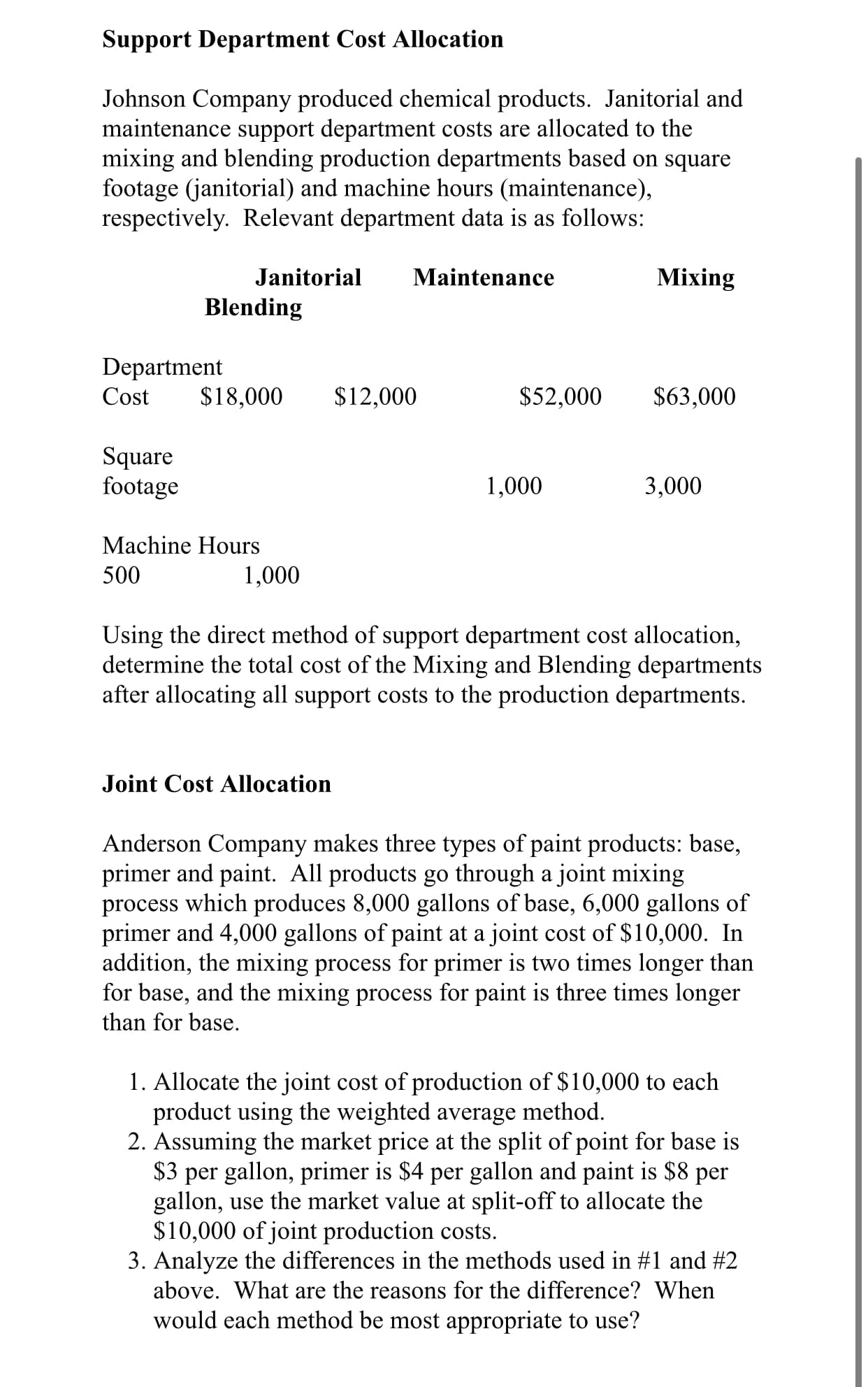Support Department Cost Allocation Johnson Company produced chemical products. Janitorial and maintenance support department costs are allocated to the mixing and blending production departments based on square footage (janitorial) and machine hours (maintenance), respectively. Relevant department data is as follows: Janitorial Maintenance Mixing Blending Department $18,000 Cost $12,000 $52,000 $63,000 Square footage 1,000 3,000 Machine Hours 500 1,000 Using the direct method of support department cost allocation, determine the total cost of the Mixing and Blending departments after allocating all support costs to the production departments. Joint Cost Allocation Anderson Company makes three types of paint products: base, primer and paint. All products go through a joint mixing process which produces 8,000 gallons of base, 6,000 gallons of primer and 4,000 gallons of paint at a joint cost of $10,000. In addition, the mixing process for primer is two times longer than for base, and the mixing process for paint is three times longer than for base. 1. Allocate the joint cost of production of $10,000 to each product using the weighted average method. 2. Assuming the market price at the split of point for base is $3 per gallon, primer is $4 per gallon and paint is $8 per gallon, use the market value at split-off to allocate the $10,000 of joint production costs. 3. Analyze the differences in the methods used in #1 and #2 above. What are the reasons for the difference? When would each method be most appropriate to use?
Support Department Cost Allocation Johnson Company produced chemical products. Janitorial and maintenance support department costs are allocated to the mixing and blending production departments based on square footage (janitorial) and machine hours (maintenance), respectively. Relevant department data is as follows: Janitorial Maintenance Mixing Blending Department $18,000 Cost $12,000 $52,000 $63,000 Square footage 1,000 3,000 Machine Hours 500 1,000 Using the direct method of support department cost allocation, determine the total cost of the Mixing and Blending departments after allocating all support costs to the production departments. Joint Cost Allocation Anderson Company makes three types of paint products: base, primer and paint. All products go through a joint mixing process which produces 8,000 gallons of base, 6,000 gallons of primer and 4,000 gallons of paint at a joint cost of $10,000. In addition, the mixing process for primer is two times longer than for base, and the mixing process for paint is three times longer than for base. 1. Allocate the joint cost of production of $10,000 to each product using the weighted average method. 2. Assuming the market price at the split of point for base is $3 per gallon, primer is $4 per gallon and paint is $8 per gallon, use the market value at split-off to allocate the $10,000 of joint production costs. 3. Analyze the differences in the methods used in #1 and #2 above. What are the reasons for the difference? When would each method be most appropriate to use?
Managerial Accounting
15th Edition
ISBN:9781337912020
Author:Carl Warren, Ph.d. Cma William B. Tayler
Publisher:Carl Warren, Ph.d. Cma William B. Tayler
Chapter5: Support Department And Joint Cost Allocation
Section: Chapter Questions
Problem 10E: Support department cost allocation comparison Refer to your answers to Exercises 7-9. Compare the...
Related questions
Question

Transcribed Image Text:Support Department Cost Allocation
Johnson Company produced chemical products. Janitorial and
maintenance support department costs are allocated to the
mixing and blending production departments based on square
footage (janitorial) and machine hours (maintenance),
respectively. Relevant department data is as follows:
Janitorial
Maintenance
Mixing
Blending
Department
$18,000
Cost
$12,000
$52,000
$63,000
Square
footage
1,000
3,000
Machine Hours
500
1,000
Using the direct method of support department cost allocation,
determine the total cost of the Mixing and Blending departments
after allocating all support costs to the production departments.
Joint Cost Allocation
Anderson Company makes three types of paint products: base,
primer and paint. All products go through a joint mixing
process which produces 8,000 gallons of base, 6,000 gallons of
primer and 4,000 gallons of paint at a joint cost of $10,000. In
addition, the mixing process for primer is two times longer than
for base, and the mixing process for paint is three times longer
than for base.
1. Allocate the joint cost of production of $10,000 to each
product using the weighted average method.
2. Assuming the market price at the split of point for base is
$3 per gallon, primer is $4 per gallon and paint is $8 per
gallon, use the market value at split-off to allocate the
$10,000 of joint production costs.
3. Analyze the differences in the methods used in #1 and #2
above. What are the reasons for the difference? When
would each method be most appropriate to use?
Expert Solution
This question has been solved!
Explore an expertly crafted, step-by-step solution for a thorough understanding of key concepts.
This is a popular solution!
Trending now
This is a popular solution!
Step by step
Solved in 3 steps with 1 images

Recommended textbooks for you

Managerial Accounting
Accounting
ISBN:
9781337912020
Author:
Carl Warren, Ph.d. Cma William B. Tayler
Publisher:
South-Western College Pub

Cornerstones of Cost Management (Cornerstones Ser…
Accounting
ISBN:
9781305970663
Author:
Don R. Hansen, Maryanne M. Mowen
Publisher:
Cengage Learning

Managerial Accounting: The Cornerstone of Busines…
Accounting
ISBN:
9781337115773
Author:
Maryanne M. Mowen, Don R. Hansen, Dan L. Heitger
Publisher:
Cengage Learning

Managerial Accounting
Accounting
ISBN:
9781337912020
Author:
Carl Warren, Ph.d. Cma William B. Tayler
Publisher:
South-Western College Pub

Cornerstones of Cost Management (Cornerstones Ser…
Accounting
ISBN:
9781305970663
Author:
Don R. Hansen, Maryanne M. Mowen
Publisher:
Cengage Learning

Managerial Accounting: The Cornerstone of Busines…
Accounting
ISBN:
9781337115773
Author:
Maryanne M. Mowen, Don R. Hansen, Dan L. Heitger
Publisher:
Cengage Learning

Financial And Managerial Accounting
Accounting
ISBN:
9781337902663
Author:
WARREN, Carl S.
Publisher:
Cengage Learning,

Principles of Cost Accounting
Accounting
ISBN:
9781305087408
Author:
Edward J. Vanderbeck, Maria R. Mitchell
Publisher:
Cengage Learning

Financial & Managerial Accounting
Accounting
ISBN:
9781337119207
Author:
Carl Warren, James M. Reeve, Jonathan Duchac
Publisher:
Cengage Learning